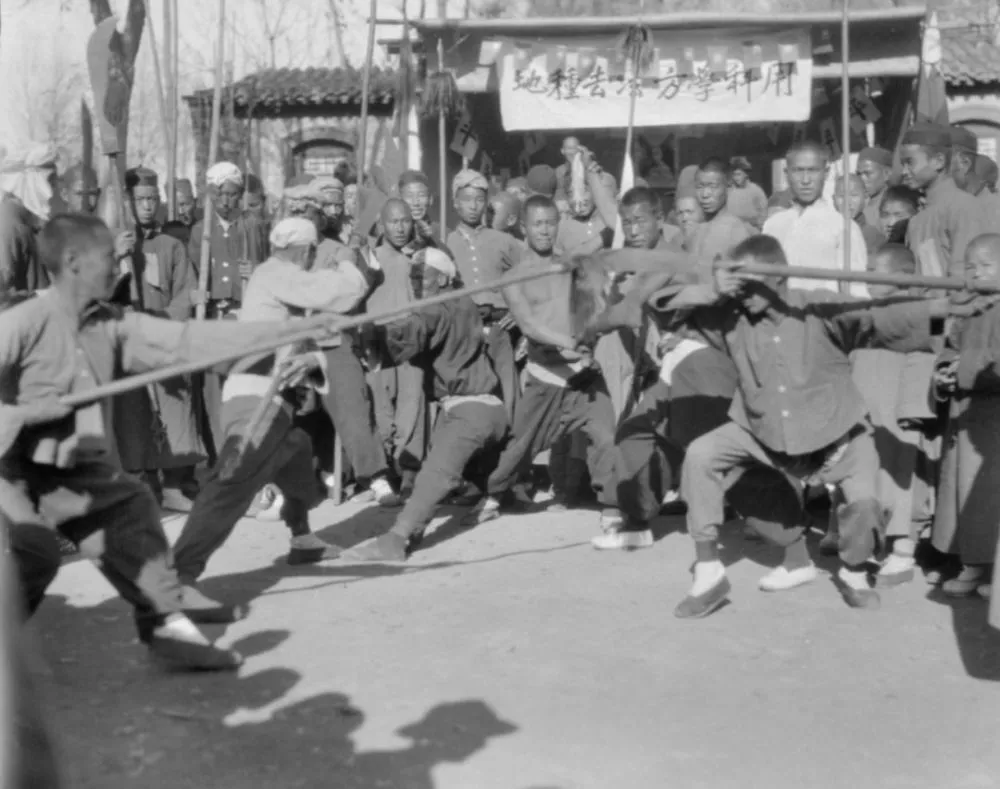Wong Wears Honor Scars: Sifu teaches tradition of Wing Chun Kung Fu
Robert Morales

Monterey Park -- Like badges of honor, Tom Wong proudly wears the scars of knife wounds on his right forearm and left hand. They are a symbol of where he has been and what the past has made him. Wong, 47, is a Master in Wing Chun Kung Fu. He learned the martial art from Grand Master Sum Neng during the cultural revolution in China in the 1960's and '70s.
Today, with the brutality he endured as a youth forever etched in his mind and on his body, Wong teaches this rare style of martial arts to about 20 students. He uses his garage as a sparring and training area, and his patio, complete with a hanging chalkboard, as his classroom. A happy fellow who appears 10 years younger than he is, Wong recalls the terror in China that led him to seek the fighting supremacy one needed to survive. "It was very common, like every day, where you would walk out, especially at night, and four or five guys would jump you," said Wong, who has taught out of his home for 20 years and also has taught at Pasadena City College. "There were many times when I fought against gangs with 12 guys. And they don't just punch you; they uses rocks, knives, chains, belts."
Wong likened those years in China to the Old West, where people killed and maimed, sometimes for no apparent reason. "You would see people killed on the street," Wong said, "and nobody cared...most people would hide out, or when they went out, they would carry swords. Everyone was isolated. They would make their own barricades. They would see a stranger come down the street, check you out, see why you are coming."
"I didn't like to fight, but I guess there was some characteristic in me; I like to win." Wong was 7 when the cultural revolution began. After enduring his share of beatings, he began taking lessons in Tai Chi when he was 11. A year later, he was introduced to Grand Master Neng, who hedged on taking such a young student. Neng soon discovered that the youthful Wong was an exceptional protege. And in a short time, it was Wong who was getting the better of unfortunate attackers. But the success did not come easily. The training, Wong said, was incredibly grueling and very painful.
Wong recalled the conditioning of the arms. Barbells with flat, instead of round, bar would be tossed into the air. With weights attached, it would land on Wong's arm. "It would come down and roll on my forearm," Wong said. "The forearm would turn red, and the second time it would turn black."
Keep in mind, he was 12.
"When I started, it was summer, and I trained three sessions a day," Wong said. "At 4 o'clock in the morning, I jogged around a small island where all the Master's trained. They were real fighters, and they practiced before the sun came up so other people cannot pass by and learn these things."
It's the same type of dedication Wong is trying to instill in his students today. Described by Wong as a soft-style martial art, his form of Wing Chun Kung Fu involves a variety of kicks and punches. Wong points out that the term "soft-style" does not mean the kicks and punches are delivered softly. They style is quite the opposite. "Soft-style means the motions are continuous," Wong said. "Hard-style art, they stop. Every hit, you see, they pose. Chinese Kung Fu artist look at boxing and consider it as soft style....Karate is a form of hard style. It's very distinguishable. You don't have to be a genius to figure it out. Soft style is very subtle. You don't see when they block, and they hit; they do it together almost. One little change of angle, and the purpose changes."
On this day, Wong demonstrates the fabled one-inch punch on one of his students. Bam! The unfortunate young man falls back several feet from the impact to his chest, which is being protected by a training pad. Wong's strength does not come from a huge man standing 7-foot and weighing 300 pounds, however. It comes from a man about 5-foot-11, 200 pounds. Sure, 30 years practicing martial arts may do that for a person. But Wong said it's more than that.
Incorporated into his training is an intangible referred to as "chi." Wong describes chi as internal strength on builds up from inside that creates a certain physical strength. When Wong arrived here in the late 1970's, he had never actually tried to bench press weights. The first time he did, he pressed 400 pounds.
So what do his student's think? Nothing but positive thoughts. Justin Bronk of Pasadena had 20 years of experience in martial arts. He studied Tae Kwon Do for seven years, and Jiu Jitsu and Judo for another 13. "I worked out with some of the top guys in L.A.," Bronk said. "And Sifu (teacher) Wong is at another level. I had 20 years martial arts; I thought I knew a lot. But after seeing this, I tossed it all aside."
So, if Wong is that good, why not open up studios and make big money? The reason is simple. As the tradition in China goes, this form of Wing Chun is not to be used for financial gain because it can lose its worth by becoming commercialized. "I don't like to tie myself down," Wong said, "and also, some of the traditional value and skill, I like to see preserved."
*Robert Morales is a staff writer for the San Gabriel Valley News. This article first appeared on the front page of the Sports section in the San Gabriel Valley News on Monday, March 27, 2000.